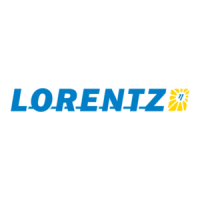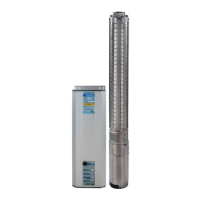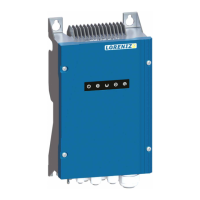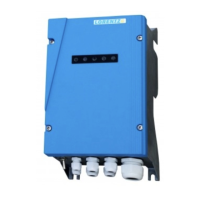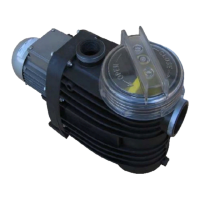


Do you have a question about the Lorentz PS1200 and is the answer not in the manual?
Critical warnings covering electrical safety, pump operation, handling, system components, and environmental factors.
Details about system components, including voltage, serial numbers, and module information.
Fields to record installation specifics, performance notes, flow rate, and AC current.
Guidance on initial system checks, the manual's scope, and the importance of the system report.
Introduction to the reference section, highlighting its helpful information on operation and technical terms.
Illustrates a PS600 300Wp solar-direct system installation, detailing array tilt and controller mounting.
Shows a PS600 system, drop pipe details, and PV array assembly, highlighting hand installation cautions.
Guidance on selecting an optimal location for the solar array, considering sun exposure, wiring, and shading.
Two methods for assembling the solar array: on the ground or piece-by-piece on the pole.
Information on solar array mounting racks, emphasizing wind resistance and the benefits of solar trackers.
Explanation and instructions for using the Sun Compass tool to orient the solar array correctly.
Options for setting the tilt angle: year-round compromise, seasonal adjustment, or seasonal use.
Formulas for calculating optimum summer and winter tilt angles based on latitude.
Guidance on locating, mounting, and protecting the controller and junction box, and using electrical conduit for wiring.
Instructions for making proper ground connections at the controller and to aluminum components.
Explains 'floating' system grounding for lightning protection and specific guidance for battery systems and wiring.
Methods for creating ground paths, bonding components, and protecting cables from lightning surges.
Safe wiring practices for solar arrays and connecting PV modules, emphasizing secure connections.
Specific instructions for wiring solar trackers, managing flexible cable, and checking motion.
Explanation of the disconnect switch's purpose for safety during installation and maintenance.
Clarification that overload protection is not required for the solar array circuit due to controller design.
Crucial safety checks before connecting power, including voltage testing and avoiding short circuits.
Details on connecting ground, power, low-water probe, and float switch to the junction box terminals.
Guidance on adjusting the Maximum RPM setting for optimal performance and reasons for reduction.
Guidance on selecting the correct approved cable and using a submersible splice kit for secure connections.
Instructions for identifying pump wires and testing rotation direction to ensure correct pump operation.
Steps to troubleshoot incorrect pump rotation and address issues specific to helical and centrifugal pump models.
Instructions for installing the low-water probe and procedures for bypassing it if not in use.
Explanation of probe operation and troubleshooting potential problems in surface water environments.
Details on float switch requirements, cable specifications, grounding, and wiring for automatic tank shutoff.
Wiring diagrams and explanations for connecting both normally open (N.O.) and normally closed (N.C.) float switches.
Procedure for setting up and wiring PS-XXX systems for battery operation, including jumper settings and direct battery connection.
Guidance on DC circuit wire sizing and explanation of the Low Voltage Disconnect function for battery protection.
Instructions for setting up PS-XXX systems for automatic water pressurization, including component selection and pressure tank requirements.
Detailed steps for pre-charging a captive-air pressure tank, essential for proper system function.
Details two methods for connecting a pressure switch: primary power switching and remote switching.
Critical warnings for handling helical rotor pumps, including avoiding machine grease and sun exposure.
Warning regarding siphon effects in low lift applications and measures to prevent motor damage.
Guidance on selecting and sizing drop pipes for PS-XXX pumps, considering sand conditions and future needs.
Note on the compatibility of the stainless steel outlet fitting with various pipe materials.
Importance and procedure for securing the pump with safety rope at the wellhead to prevent loss.
Instructions for binding the drop pipe, electrical cable, wires, and safety rope together along the pipe length.
Guidance on pump positioning in surface sources, stream installation, and intake filtration to prevent debris.
Critical advice on low-water probe positioning and determining the need for a flow sleeve.
Factors to consider when setting pump depth in deep wells, including costs, sand risk, and the need for accurate well data.
Strategies for avoiding or managing dirty water conditions, including well improvement and pipe sizing.
Techniques for maximizing water draw from low-production sources, including using the low-water probe and adjusting RPM.
Information on integrating PS-Pumps with windmills or hand pumps, utilizing dual energy sources.
Requirement for a bypass assembly with a foot valve when using helical rotor pumps under cylinders.
Details on rubber spacers used in specific pump models to reduce vibration transferred to the well casing.
Guidelines for professional installation using standard AC submersible pump equipment.
Cautions and procedures for hand installation, including handling polyethylene pipe and potential hazards.
Instructions for sanitizing wells to kill bacteria and warnings about potential damage to PS-Pumps from chlorine.
Explanation of the POWER switch function and the meaning of various indicator lights on the pump controller.
Method of indicating pump speed by counting the flashes of the PUMP ON LED.
Steps for starting the pump, conditions for solar-direct startup, and behavior under weak sun.
Guidance on pump behavior during shadows, time delays, quick starts, vibration, and pump overload conditions.
Instructions for controller removal and initial troubleshooting steps when the pump does not run.
Specific diagnostic steps for pumps that attempt to start but fail, and troubleshooting pump overload indications.
Checklist for inspecting the solar array, wires, connections, controller, and junction box for issues.
Procedures for checking the low-water probe and full-tank float switch systems, including bypass tests.
Essential electrical tests for the solar array circuit, motor circuit resistance, and running current.
Guidance on interpreting electrical test results, including AC running current tables and causes of higher current.
Potential causes for lower motor current, such as water level variations, worn pump heads, or pipe leaks.
Detailed electrical tests for the low-water probe and float switch circuits to diagnose operational issues.
Steps to diagnose reduced water flow, checking array performance, pump selection, pipe sizing, leaks, current draw, and RPM settings.
Procedures for investigating causes of flow decrease over time, including worn components or sediment issues.
Sections for recording contact information and identifying the pump system's model and configuration details.
Fields for documenting crucial well and water source data, including depth, water levels, and pipe configuration.
Space to describe the problem, initial checks on probes, pre-installation tests, and RPM control settings.
Section to record electrical measurements taken during troubleshooting, referencing specific test procedures.
Instructions for measuring motor current, resistance, and resistance to ground, crucial for diagnosing faults.
Inquiry regarding water temperature and its potential impact on the helical rotor stator.
Overview of electrical tests to assess system performance and locate faults, with guidance on using multimeters.
Illustrated procedures for testing the solar array circuit, including voltage and current measurements.
Visual illustrations demonstrating the setup and execution of solar array electrical tests.
Illustrated tests for the pump circuit, focusing on AC current draw and resistance measurements.
Illustrated tests for the low-water probe and float/pressure switch circuits to diagnose operational issues.
Visual guides for measuring pump speed via LED flashes and motor current using clamp-on ammeters.
Illustrations for testing motor resistance and wiring for normally open/closed float or pressure switches.
Maintenance guidelines for controller, junction box, and pump motor, emphasizing inspection and cleaning.
Maintenance procedures for the solar array, including checking bolts, clearing sun exposure, and cleaning.
Inspection of power wiring and grounding system to ensure integrity and prevent faults.
Details on warranty coverage for pumps and controllers, including exclusions and conditions that void the warranty.
Customer responsibility for safe installation and controller compliance with standards and environmental conditions.
Specifications for optimum operating and storage temperature ranges for pumps and controllers.
Explanation of how solar arrays, PV cells, brushless motors, controllers, and pump ends function.
Description of centrifugal and helical rotor pump ends, their operational principles, and characteristics.
Detailed explanation of the mechanics, positive displacement action, and self-cleaning features of helical rotor pumps.
Brief historical context of helical rotor pump applications, including their use in the oil industry.
Emphasis on using the chart to select pipe size, avoiding friction loss and ensuring proper system performance.
Charts detailing friction loss in plastic pipe and peak flow rates for different pump models for pipe sizing.
Methods for sealing the wellhead and supporting the in-well assembly, including Well Seal and Pitless Adapter systems.
Explanation of the check valve's role in preventing back-flow and its omission for freeze protection.
Guidance on selecting storage tank capacity and common plumbing configurations, including reserve supply.
Advice on pipe sizing for storage tanks, water pressure, and purification requirements.
Methods for monitoring pump output and water levels in storage tanks to ensure proper system operation.
Strategies for freeze protection, including pressure relief valves, pipe burial, and weep holes.
Information on the freeze tolerance of polyethylene pipe and its suitability for cold climates.
Guidance on selecting appropriate multimeters and ammeters for electrical testing, including range specifications.
Tips for accurate meter usage, including zero adjustment and proper probe connection.
Explanation of why measuring solar intensity is crucial for evaluating solar-direct pumps, and information on the Daystar Meter.
Definitions of fundamental electrical terms including AC, DC, current, voltage, efficiency, and power.
Definitions of solar electricity terms such as Charge Controller, Battery Systems, and Photovoltaic principles.
Definitions for various pump types (Booster, Centrifugal, Helical Rotor) and motor types (Brush, Brushless).
Definitions for PV system components like arrays, modules, trackers, and voltage specifications.
Definitions for various pump types, water well components, and related system parts.
Definitions for different DC and AC motor types used in pumping applications.
Definitions of electronic devices like Linear Current Booster (LCB), MPPT, and Pump Controller.
Definitions for essential water well components including borehole, casing, drop pipe, pitless adapters, and safety ropes.
Definitions for water well characteristics and pump system engineering terms like friction loss and head.
Definitions related to water distribution, pressure, gravity flow, and pressure switches.
Definition of pressure tank precharge and formulas for calculating pumping efficiency and power requirements.
Overview of the wiring diagram and instructions for connecting PV modules, including voltage checks.
Instructions for connecting the low-water probe, float switch, and battery system jumpers as per the diagram.
Critical warnings covering electrical safety, pump operation, handling, system components, and environmental factors.
Details about system components, including voltage, serial numbers, and module information.
Fields to record installation specifics, performance notes, flow rate, and AC current.
Guidance on initial system checks, the manual's scope, and the importance of the system report.
Introduction to the reference section, highlighting its helpful information on operation and technical terms.
Illustrates a PS600 300Wp solar-direct system installation, detailing array tilt and controller mounting.
Shows a PS600 system, drop pipe details, and PV array assembly, highlighting hand installation cautions.
Guidance on selecting an optimal location for the solar array, considering sun exposure, wiring, and shading.
Two methods for assembling the solar array: on the ground or piece-by-piece on the pole.
Information on solar array mounting racks, emphasizing wind resistance and the benefits of solar trackers.
Explanation and instructions for using the Sun Compass tool to orient the solar array correctly.
Options for setting the tilt angle: year-round compromise, seasonal adjustment, or seasonal use.
Formulas for calculating optimum summer and winter tilt angles based on latitude.
Guidance on locating, mounting, and protecting the controller and junction box, and using electrical conduit for wiring.
Instructions for making proper ground connections at the controller and to aluminum components.
Explains 'floating' system grounding for lightning protection and specific guidance for battery systems and wiring.
Methods for creating ground paths, bonding components, and protecting cables from lightning surges.
Safe wiring practices for solar arrays and connecting PV modules, emphasizing secure connections.
Specific instructions for wiring solar trackers, managing flexible cable, and checking motion.
Explanation of the disconnect switch's purpose for safety during installation and maintenance.
Clarification that overload protection is not required for the solar array circuit due to controller design.
Crucial safety checks before connecting power, including voltage testing and avoiding short circuits.
Details on connecting ground, power, low-water probe, and float switch to the junction box terminals.
Guidance on adjusting the Maximum RPM setting for optimal performance and reasons for reduction.
Guidance on selecting the correct approved cable and using a submersible splice kit for secure connections.
Instructions for identifying pump wires and testing rotation direction to ensure correct pump operation.
Steps to troubleshoot incorrect pump rotation and address issues specific to helical and centrifugal pump models.
Instructions for installing the low-water probe and procedures for bypassing it if not in use.
Explanation of probe operation and troubleshooting potential problems in surface water environments.
Details on float switch requirements, cable specifications, grounding, and wiring for automatic tank shutoff.
Wiring diagrams and explanations for connecting both normally open (N.O.) and normally closed (N.C.) float switches.
Procedure for setting up and wiring PS-XXX systems for battery operation, including jumper settings and direct battery connection.
Guidance on DC circuit wire sizing and explanation of the Low Voltage Disconnect function for battery protection.
Instructions for setting up PS-XXX systems for automatic water pressurization, including component selection and pressure tank requirements.
Detailed steps for pre-charging a captive-air pressure tank, essential for proper system function.
Details two methods for connecting a pressure switch: primary power switching and remote switching.
Critical warnings for handling helical rotor pumps, including avoiding machine grease and sun exposure.
Warning regarding siphon effects in low lift applications and measures to prevent motor damage.
Guidance on selecting and sizing drop pipes for PS-XXX pumps, considering sand conditions and future needs.
Note on the compatibility of the stainless steel outlet fitting with various pipe materials.
Importance and procedure for securing the pump with safety rope at the wellhead to prevent loss.
Instructions for binding the drop pipe, electrical cable, wires, and safety rope together along the pipe length.
Guidance on pump positioning in surface sources, stream installation, and intake filtration to prevent debris.
Critical advice on low-water probe positioning and determining the need for a flow sleeve.
Factors to consider when setting pump depth in deep wells, including costs, sand risk, and the need for accurate well data.
Strategies for avoiding or managing dirty water conditions, including well improvement and pipe sizing.
Techniques for maximizing water draw from low-production sources, including using the low-water probe and adjusting RPM.
Information on integrating PS-Pumps with windmills or hand pumps, utilizing dual energy sources.
Requirement for a bypass assembly with a foot valve when using helical rotor pumps under cylinders.
Details on rubber spacers used in specific pump models to reduce vibration transferred to the well casing.
Guidelines for professional installation using standard AC submersible pump equipment.
Cautions and procedures for hand installation, including handling polyethylene pipe and potential hazards.
Instructions for sanitizing wells to kill bacteria and warnings about potential damage to PS-Pumps from chlorine.
Explanation of the POWER switch function and the meaning of various indicator lights on the pump controller.
Method of indicating pump speed by counting the flashes of the PUMP ON LED.
Steps for starting the pump, conditions for solar-direct startup, and behavior under weak sun.
Guidance on pump behavior during shadows, time delays, quick starts, vibration, and pump overload conditions.
Instructions for controller removal and initial troubleshooting steps when the pump does not run.
Specific diagnostic steps for pumps that attempt to start but fail, and troubleshooting pump overload indications.
Checklist for inspecting the solar array, wires, connections, controller, and junction box for issues.
Procedures for checking the low-water probe and full-tank float switch systems, including bypass tests.
Essential electrical tests for the solar array circuit, motor circuit resistance, and running current.
Guidance on interpreting electrical test results, including AC running current tables and causes of higher current.
Potential causes for lower motor current, such as water level variations, worn pump heads, or pipe leaks.
Detailed electrical tests for the low-water probe and float switch circuits to diagnose operational issues.
Steps to diagnose reduced water flow, checking array performance, pump selection, pipe sizing, leaks, current draw, and RPM settings.
Procedures for investigating causes of flow decrease over time, including worn components or sediment issues.
Sections for recording contact information and identifying the pump system's model and configuration details.
Fields for documenting crucial well and water source data, including depth, water levels, and pipe configuration.
Space to describe the problem, initial checks on probes, pre-installation tests, and RPM control settings.
Section to record electrical measurements taken during troubleshooting, referencing specific test procedures.
Instructions for measuring motor current, resistance, and resistance to ground, crucial for diagnosing faults.
Inquiry regarding water temperature and its potential impact on the helical rotor stator.
Overview of electrical tests to assess system performance and locate faults, with guidance on using multimeters.
Illustrated procedures for testing the solar array circuit, including voltage and current measurements.
Visual illustrations demonstrating the setup and execution of solar array electrical tests.
Illustrated tests for the pump circuit, focusing on AC current draw and resistance measurements.
Illustrated tests for the low-water probe and float/pressure switch circuits to diagnose operational issues.
Visual guides for measuring pump speed via LED flashes and motor current using clamp-on ammeters.
Illustrations for testing motor resistance and wiring for normally open/closed float or pressure switches.
Maintenance guidelines for controller, junction box, and pump motor, emphasizing inspection and cleaning.
Maintenance procedures for the solar array, including checking bolts, clearing sun exposure, and cleaning.
Inspection of power wiring and grounding system to ensure integrity and prevent faults.
Details on warranty coverage for pumps and controllers, including exclusions and conditions that void the warranty.
Customer responsibility for safe installation and controller compliance with standards and environmental conditions.
Specifications for optimum operating and storage temperature ranges for pumps and controllers.
Explanation of how solar arrays, PV cells, brushless motors, controllers, and pump ends function.
Description of centrifugal and helical rotor pump ends, their operational principles, and characteristics.
Detailed explanation of the mechanics, positive displacement action, and self-cleaning features of helical rotor pumps.
Brief historical context of helical rotor pump applications, including their use in the oil industry.
Emphasis on using the chart to select pipe size, avoiding friction loss and ensuring proper system performance.
Charts detailing friction loss in plastic pipe and peak flow rates for different pump models for pipe sizing.
Methods for sealing the wellhead and supporting the in-well assembly, including Well Seal and Pitless Adapter systems.
Explanation of the check valve's role in preventing back-flow and its omission for freeze protection.
Guidance on selecting storage tank capacity and common plumbing configurations, including reserve supply.
Advice on pipe sizing for storage tanks, water pressure, and purification requirements.
Methods for monitoring pump output and water levels in storage tanks to ensure proper system operation.
Strategies for freeze protection, including pressure relief valves, pipe burial, and weep holes.
Information on the freeze tolerance of polyethylene pipe and its suitability for cold climates.
Guidance on selecting appropriate multimeters and ammeters for electrical testing, including range specifications.
Tips for accurate meter usage, including zero adjustment and proper probe connection.
Explanation of why measuring solar intensity is crucial for evaluating solar-direct pumps, and information on the Daystar Meter.
Definitions of fundamental electrical terms including AC, DC, current, voltage, efficiency, and power.
Definitions of solar electricity terms such as Charge Controller, Battery Systems, and Photovoltaic principles.
Definitions for various pump types (Booster, Centrifugal, Helical Rotor) and motor types (Brush, Brushless).
Definitions for PV system components like arrays, modules, trackers, and voltage specifications.
Definitions for various pump types, water well components, and related system parts.
Definitions for different DC and AC motor types used in pumping applications.
Definitions of electronic devices like Linear Current Booster (LCB), MPPT, and Pump Controller.
Definitions for essential water well components including borehole, casing, drop pipe, pitless adapters, and safety ropes.
Definitions for water well characteristics and pump system engineering terms like friction loss and head.
Definitions related to water distribution, pressure, gravity flow, and pressure switches.
Definition of pressure tank precharge and formulas for calculating pumping efficiency and power requirements.
Overview of the wiring diagram and instructions for connecting PV modules, including voltage checks.
Instructions for connecting the low-water probe, float switch, and battery system jumpers as per the diagram.
| Brand | Lorentz |
|---|---|
| Model | PS1200 |
| Category | Water Pump |
| Language | English |
